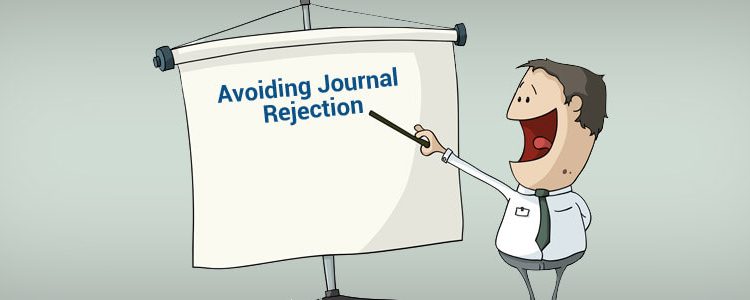Learning to Avoid Journal Rejection

In academic publishing, journal rejection rates can vary widely. According to the American Psychological Association’s 2013 report, its top journals averaged a rejection rate of about 76 percent. Elsevier, one of the largest publishers in the world, claims a rate of 30 to 50 percent, and a 2013 article in Nature Materials reported a rate of about 87 percent, with only about 60 percent accepted after peer review. This is very discouraging to scholars who spend years planning their research, securing funding, compiling and analyzing data, and making sound conclusions that could benefit their readers. Before submitting your manuscript to a journal for publication, do your homework. Research the journal’s standards and formats and know its rejection rates. Knowing the most common reasons for rejection will help ensure that your manuscript receives a thorough review so that you can address any questions and concerns and resubmit.
Reasons for Rejection
“Contrary to popular belief, editors do not like rejecting submissions”, states Jon Billsberry, an editor with the Journal of Management Education (JME). In his 2014 editorial “Desk-Rejects: 10 Top Tips to Avoid the Cull,” Billsberry points out that even though his journal has clear author guidelines, often presented at conferences and workshops, authors continue to submit substandard papers. Billsberry, along with Dr. Peter Thrower, Editor-in-Chief of Carbon, has provided the top reasons that articles are rejected.
- Technical screening
- Domain
- Contribution
- Length
- Underdeveloped manuscripts
- Language
- Relevance/Journal references
- Methods
- Conclusions
- Format
Technical screening (also domain or scope) is the first pass made by editors to analyze whether the subject is appropriate for the journal. References are reviewed for plagiarism, checks are made to determine whether the paper is under review elsewhere (duplicate submission is not allowed), and papers are checked for completeness according to the journal’s guidelines (e.g., title, author names, and affiliations, etc.). Manuscripts must be written in English and the grammar and syntax must be such that it can be properly peer reviewed. An editor is not going to spend time trying to decipher a paper that is incomprehensible.
JME often rejects a manuscript simply because it does not contribute anything new to JME’s main focus, which is organizational behavior and management, with sub-core areas in “human resource management and strategic management marketing, finance, and entrepreneurship.” Although papers in these sub-core areas will be accepted, they must have relevance to the journal’s main focus. If there is nothing new on the subject or conclusions are not validated and cannot be justified based on results, journal editors will reject the paper.
Journals have space restrictions; therefore, adhering to length specifications is important. Editors are not fooled by wider margins and smaller fonts and will be apt to reject your paper outright because of this attempt at noncompliance. Author guidelines have specific formatting requirements, such as using correct reference/citation styles; using the correct format for tables and figures, including placement; use of color, and use of headers and their alignment.
The language also refers to whether your paper is written in the first or third person. We no longer must always use the third person; editors prefer the first person, and explanatory rather than declarative language. In other words, don’t just tell the reader what the results are, explain how they were determined. For references, you don’t necessarily have to cite references from previous issues of journals, but, if not, editors will scrutinize the paper further; therefore, choose your references carefully.
The methods section is extremely important part of the manuscript. Anyone reading your paper must be able to duplicate your research by following the steps described in this section. Papers are often rejected when methods are incomplete or don’t include the required subsections. The paper are also rejected if the editors believe that the study did not follow proper scientific methods (e.g., no control group; invalid data/analyses), presents arguments that are “illogical, unstructured, or invalid,” or if your findings are “incremental and do not advance the field” or that your “work is clearly part of a larger study, chopped up to make as many articles as possible.”
Tips to Follow
- In addition to addressing the above points, timing is very important. According to a Koonec article, you should decide on your goals even before beginning your study, including how much data are sufficient, what figures would be used, and whether the journal’s publishing schedule fits with yours. Do your research on several journals (e.g., scope, impact factor, readership, rejection rates), including discussing them with colleagues, to decide in advance to which one you will submit.
- Make sure that your abstract is complete and concise, and that it presents all the required subsections. This is the first thing a reviewer will see and sets the tone of your manuscript. Evaluate whether your study is going to contribute new information on your subject. If so, your paper will be of more interest. The most prestigious journals require groundbreaking research. If you can’t demonstrate this, try submitting to a journal with a lower impact factor. Always double check your data and calculations. Ensure that data in your tables and figures reflect those in the text and use consistent language (e.g., don’t use “control” group in text and “non-experimental” group elsewhere). Be logical when presenting data and conclusions.
- Have colleagues and peers review the paper. They would not only bring fresh perspectives and helpful suggestions but will also identify minor errors that might have been overlooked. This is of great help while making necessary revisions prior to submission.
- Finally, have your paper edited by a professional editing service, whether English is your native language or you have English as a second language (ESL). These services have editors with backgrounds in your discipline, are of great help in manuscript preparation, are familiar with different styles, and specialize in working with ESL writers.









